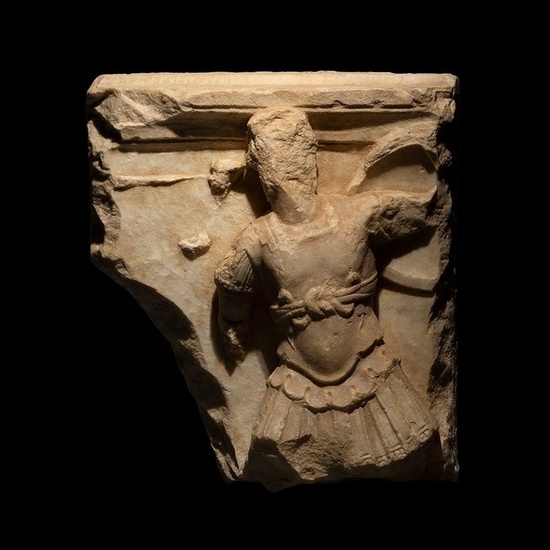Ancient Roman Marble Fragment of a sarcophagus for a soldier H: 43 cm. Spanish Export License.
Fragment of a sarcophagus for a soldier\r
Roman\r
1st – 2nd century AD\r
Marble\r
Height 43 cm\r
\r
PROVENANCE: Private collection, Connecticut (USA) . 1980. \r
\r
CONDITION: A fragment from the cube of a sarcophagus, in a good state of preservation, without restoration. Most of the head of the figure is damaged. \r
\r
DESCRIPTION: \r
\r
A fragment from a side of a sarcophagus worked from one piece of marble. The piece is in high relief and represents a scene from a battle. We can see an almost complete figure of a soldier. As part of the face is missing, we cannot be sure of the identity, but it could be of a particular hero or warrior. The body is in semi-profile, with the figure looking to the right, where a battle is taking place. He is raising his shield, holding it in his left hand, while with his right arm he would have been holding a sword in the hand and brandishing it toward the enemy. \r
\r
The relief has a flat background with an arched vertex above the figure indicating the upper limit of the cube. Therefore, this element corresponds to a scene on the front of the cube, as the smooth upper surface marks the area where the lid would have been in contact. It is clear to see how skilled the workmen who carved this scene were: the background has been carefully smoothed, the anatomy of the soldier rendered in detail and in depth. The head of the figure - in high relief – is almost separated from the rest of the background. It is, without doubt, an example from an important tomb given its technical and artistic level. \r
\r
This male torso is part of a complete sculpture of a soldier. Although it might seem that he is wearing the armour directly over his body, it was normal under the armour to also wear a tunic or colobium which fell to the knees and which had short sleeves. In sculptures on a larger scale or on a life-size scale, such tunics can be seen. In this case, particularly as the legs are missing, we cannot be sure that the artisan sculpted this garment. \r
\r
Notes: \r
\r
The piece includes authenticity certificate. \r
The piece includes Spanish Export License (Passport for European Union) - If the piece is destined outside the European Union a substitution of the export permit should be requested. This process could take between 1 and 2 months. \r
THE MINISTRY OF CULTURE FROM SPAIN ASKS ALL SELLERS FOR INVOICES OR OTHER DOCUMENTATION ABLE TO PROVE THE LEGALITY OF EACH ITEM BEFORE PROVIDING AN IMPORT OR EXPORT LICENSE. \r
#Julius. Caesar\r
\r
View it on
Estimate
Time, Location
Auction House
Fragment of a sarcophagus for a soldier\r
Roman\r
1st – 2nd century AD\r
Marble\r
Height 43 cm\r
\r
PROVENANCE: Private collection, Connecticut (USA) . 1980. \r
\r
CONDITION: A fragment from the cube of a sarcophagus, in a good state of preservation, without restoration. Most of the head of the figure is damaged. \r
\r
DESCRIPTION: \r
\r
A fragment from a side of a sarcophagus worked from one piece of marble. The piece is in high relief and represents a scene from a battle. We can see an almost complete figure of a soldier. As part of the face is missing, we cannot be sure of the identity, but it could be of a particular hero or warrior. The body is in semi-profile, with the figure looking to the right, where a battle is taking place. He is raising his shield, holding it in his left hand, while with his right arm he would have been holding a sword in the hand and brandishing it toward the enemy. \r
\r
The relief has a flat background with an arched vertex above the figure indicating the upper limit of the cube. Therefore, this element corresponds to a scene on the front of the cube, as the smooth upper surface marks the area where the lid would have been in contact. It is clear to see how skilled the workmen who carved this scene were: the background has been carefully smoothed, the anatomy of the soldier rendered in detail and in depth. The head of the figure - in high relief – is almost separated from the rest of the background. It is, without doubt, an example from an important tomb given its technical and artistic level. \r
\r
This male torso is part of a complete sculpture of a soldier. Although it might seem that he is wearing the armour directly over his body, it was normal under the armour to also wear a tunic or colobium which fell to the knees and which had short sleeves. In sculptures on a larger scale or on a life-size scale, such tunics can be seen. In this case, particularly as the legs are missing, we cannot be sure that the artisan sculpted this garment. \r
\r
Notes: \r
\r
The piece includes authenticity certificate. \r
The piece includes Spanish Export License (Passport for European Union) - If the piece is destined outside the European Union a substitution of the export permit should be requested. This process could take between 1 and 2 months. \r
THE MINISTRY OF CULTURE FROM SPAIN ASKS ALL SELLERS FOR INVOICES OR OTHER DOCUMENTATION ABLE TO PROVE THE LEGALITY OF EACH ITEM BEFORE PROVIDING AN IMPORT OR EXPORT LICENSE. \r
#Julius. Caesar\r
\r



